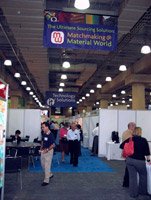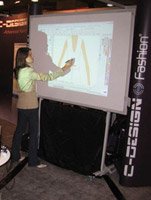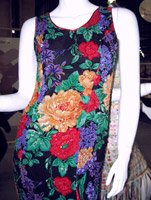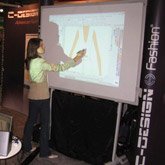Eco Part of the Draw at Material World N.Y.
The organic world was in full bloom at the Material World New York show as vendors put the spotlight on sustainable fabrics as well as sourcing and technology Sept. 25–27 at the Jacob K. Javits Convention Center.
The third edition of the show appeared to be moderately trafficked during the three-day event, with buyers coming and going in waves. Show co-producer Urban Expositions, based in Kennesaw, Ga., does not disclose buyer attendance, but about 450 exhibitors were on hand.
“We were very pleased with the show because our exhibitors were pleased,” said Tim von Gal, president of Urban Expositions. “It takes about three shows for a show to find its level and define itself. This show is still strong in fabrics and trimmings. It took a nice step forward in apparel production, with more contractors participating this time. Home furnishings [fabrics] continue to be strong.”
While eco-friendly fabrics grabbed the lion’s share of attention at the show, nanotechnology-based fibers and fabrics for activewear and fashion uses were also highlighted.
The growth in organic fabrics is beingfueled by trend as well as environmental concerns, said representatives at the Fountain Set USA Inc. booth.
“Last show, we had maybe half of a rack for eco. Now it’s half the booth,” said marketing manager Josie Hua. “It’s really caught on over the past six to eight months.” Fountain Set showed a range of eco-fabrics, including bamboo, corn, and recycled polyester and cotton. The company, based in Hong Kong, is also extending the eco theme into its corporate practices. It has invested in the development of non-water carbon dioxide–based dyeing and effluent recycling.
The corporate- and social-responsibility banner was waved throughout the show. During the headliner panel discussion on environmental sustainability, company representatives debated about the costs involved in producing and marketing eco products as well as the certification process.
“We’re in an industry that, in reality, creates a lot of garbage,” said Monica DeVreese, brand manager for Carpinteria, Calif.–based Simple Shoes. “The idea is to leave it [the environment] in better condition than you find it.”
Mark Messura, executive vice president of Cotton Inc., said the organization is looking for ways to reduce the impact of production through streamlining processes.
“It’s not about the end measures so much,” he said. “After all, there’s no way to detect the differences [between organic and non-organic fabrics].”
The panelists agreed that textile and apparel companies will be facing some new challenges in adopting green programs. In the meantime, suppliers are capitalizing on demand.
The Fenton, Mo.–based Carr Textile Corp. rolled out a stock program for organic cotton twill in 24 colors. The fabrics are certified and whitened using hydrogen peroxide instead of chlorine bleach. The dyeing is done with low-impact dyes rather than traditional heavy-metal dyes.
The reaction was strong, said sales representative Lou Greco. The company plans to expand into recycled polyester, he said.
David Boyer of Boyer Associates, representing Korean company Fine International, was scoring on aloe- and vitamin E–based fabrics as well as pearl-and soy-based products. The applications have been appealing to sock makers, said Boyer.
Technical fabrics continue to emerge. Among the more interesting products were silver-based fabrics being produced under the Taiwan Textile Federation. Examples included socks that can ward off odor and moisture for up to a week.
Martinsville, Va.–based Solid Stone Fabrics was busy throughout the show with its line of iridescent foils, including a series that changes patterns while being stretched.
The materials were developed using the company’s new environmentally friendly“e-foil” process, which doesn’t produce any byproducts. Swimwear makers were especially drawn to the fabric.
It was slower going for traditional fabric vendors. The weakening dollar is hurting business abroad. Barry McLaughlin of Canadian resource Zinman Textiles said the Canadian dollar is just about even with the U.S. dollar, advancing from about 65 cents only two years ago. The company was offering linings in varying weights.
Sayed Raghib Hussain of Romana Art said his embellished Indian silks are performing strong with his client base of designers that specialize in better goods.
“It’s been pretty good,” he said. “We’ve seen all the big designers.”
Rita Saghian of Los Angeles–based Elyan Enterprises reported lackluster traffic for the company’s line, which included sequined organza and tulle.
Attendees ranged from designers to contractors. Helen Preysler, a designer for Forwear, based in New York, was impressed by the novelty fabrics and jacquards and “anything with a gold tone or foil print.”
“There are lots of exciting textures here,” she said.
Attendee Stefanie Zeldin of Philadelphia-based Jimtex Yarns was on hand to learn more about the eco industry. Her company develops recycled yarns from textile wastes. The process helps to reduce pressure on landfills and saves water because there’s no dyeing or pesticide use.
Sourcing under scrutiny
The recent recalls of Chinese-made products have put offshore manufacturing under further scrutiny. The most notable case originated from toy maker Mattel Inc., which recalled more than 20 million toys this past summer.
Attorney and trade expert Thomas G. Travis, who was at the show promoting his book, “The Essential Guide to Going Global,” said the debacle has heightened issues of product integrity and offshore manufacturing that U.S. brands will have to take into consideration.
“These issues, along with security issues, are going to be with us for a while,” he said. In addition, the proliferation of free-trade agreements—figuring out the best way to take advantage of them and their short supply provisions—is going to influence where distributors and importers decide to source, he said.
Competing nations were trying to capitalize on the problems in China.
Vanessa Adams, director of exports for U.S. Aid, an organization that promotes trade in West Africa, said there are better reasons to diversify sourcing these days.
“The cost of labor is going up in China,” she said. “Then, there’s the backlog of shipping. When you do the math, it does not always add up.”
The West African hub has about 10 factories, many of which are stocked with Gerber cutters and high-tech equipment that can produce a range of products. Lately, uniform makers have been heading to the region.
Indonesian manufacturers staged a large pavilion at the show as part of a program to attract U.S. brands. Among the exhibitors was Haiku Apparel, which provides branded and private-label apparel manufacturing. Representative Tamara Stratton showed tie-dyed shirts, cropped pants and cargo shorts in spicy colors.
Stratton said the country is competing with handicraft skills as well as customization and service.
“We have good quality fabrics, natural resources to draw from and exceptional aesthetics,” she said.
Fewer vendors at Technology Solutions
Technology providers were fewer in number as many of the leading companies were saving their resources for the upcoming Apparel Tech Conference Nov. 7–8 at the Fashion Institute of Technology in New York. Notably absent were Lectra and Gerber Technology. Still, key software and design-products vendors were on hand and made some inroads with the largely design and contractor attendee base.
Minneapolis-based Lawson Software highlighted its new Fashion Quick Step pre-configured ERP (enterprise resource planning) package as well as its new 7.1 enterprise system, both of which help companies manage supply-chain tasks such as financials, sales, projections, order processing and delivery.
“[Fashion Quick Step] can be implemented more quickly,” explained Robert McKee, industry strategy director for fashion at Lawson. “There’s less risk. It gives an organization a starting point.”
Lawson recently signed on retailer Hot Topic to use its business intelligence module.
Miami Lakes, Fla.–based New Generation Computing was also highlighting its Red Horse ERP as well as e-SPS sourcing and e-PLM packages. PLM (product lifecycle management) has been especially sought after during the past year. NGC is coming off a record year, reflecting the trend.
“Companies are being faced with having to develop more styles to make the same amount of money,” said NGC Vice President Fred Isenberg. “The market is compressing more quickly, so you have to throw technology at it.” PLM software—which manages pre-production processes such as materials specs, costing and samples—is coming of age, Isenberg said. “We’ve told the story for the past three years. Now, the sales are coming, and it’s a reality.”
Citing industry data, Isenberg noted that PLM can reduce production-cycle time by between 20 percent and 50 percent and can reduce expenses by between 5 percent and 20 percent.
On the design front, companies such as Los Angeles–based TukaTech were catering to the large crop of fashion students at the show as well as independent and corporate designers with its digital development tools and rental programs, which start at $25.
The TukaTech Photo to Proto system allows users to create designs and patterns using the company’s CAD system and then import them into a 3-D motion simulator to fit test a garment before sending the digital file to the sample room.
“It has worked out great for merchandising and fitting,” said Jason Delevan of TukaTech.
French company C-Design, in association with software giant Corel, showed its pre-configured design application, which caters to the fast-fashion producers. The program’s existing library of garments can be manipulated and altered to create a final sketch as well as tech packs. It also can be used as a visual merchandising tool, said C-Design Chief Executive Officer Patrick Abbou.
New York–based Optitex USA Inc. connected with three deals at the show, according to President Yoram Burg, who said: “We weren’t expecting much. The show was too close to the Jewish holiday, and the U.N. conference was taking place.”

























